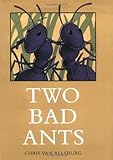The Solution to Reading Comprehension
Lessons & Units :: Two Bad Ants 2nd Grade Unit
Read-Aloud Lesson: Two Bad Ants
Lesson Plan
Two Bad Ants | 780L

- Learning Goal
- Analyze the language and illustrations to identify the settings in the story, and then determine the theme.
- Necessary Materials
- Provided:
- Detailed lesson plan
- Graphic organizer for guided practice
- Independent student worksheet
Not Provided:
Two Bad Ants
-
This lesson is a close reading of the entire text. So it’s important to engage students often, to enhance their learning. Here are two tips:
- When you ask the more complex questions from the lesson, ask students to “turn-and-talk” or “buddy-talk” before answering.
-
Once you are deep into the lesson, instead of asking students every question provided, ask them to share with you what questions they should be asking themselves at that point in the text. This is also a great opportunity to use "turn-and-talk."
- Suggested teacher language is included in the lesson.
- We recommend you read the book once to your students, either the day or morning before teaching the lesson.
- This research-based, read-aloud lesson may seem long. Why do students need the lesson to be this way?
Part 1: Teacher Modeling and Questioning
Write the following student-friendly learning goal on the board, then read the learning goal out loud with the class:
We will use the words and pictures in this story to figure out where the characters go.
Transition Students into the Text
Teacher says: Imagine you are an ant. How would the world around you look different? Let’s read a story about two ants to find out.
Read pages 4 and 5 (the first two pages of the story) out loud, then stop. Page 5 ends with, “...a happy place.” Show illustrations. Unless otherwise directed, always show students the illustrations on the pages you read throughout the lesson.
1.
Teacher asks: What does the scout ant bring to the ant queen?
Students answer: The scout ant brings a crystal to the ant queen.
2.
Teacher asks: What happens after the ant queen takes a bite?
Students answer: The ant queen quickly eats the entire thing.
3.
Teacher asks: Does the ant queen like the crystal? Support your answer with information from the story.
Students answer:
- Yes, the ant queen likes the crystal. She quickly eats the entire thing.
- Yes, the ant queen likes the crystal. She thinks it is the most delicious food she has ever tasted.
- Yes, the ant queen likes the crystal. Nothing could make her happier than to have more.
4.
Teacher asks: The book tells us that the ant queen is the mother of all the ants. Where does this ant family live? If you cannot remember from what we read, use the pictures to help you. [show illustrations again]
Students answer (may vary but should resemble the following):
- The ant family lives in a nest.
- The ant family lives in tunnels.
- The ant family lives in a hole under the ground.
5.
Teacher says: Let’s review what we just read. A scout ant has brought a crystal to the queen. The queen thinks the crystal is the most delicious food she has ever tasted. Now the ants want to gather more crystals because they want to make their queen happy. Let’s see whether they are able to gather more crystals.
Part 2: Guided Practice and Discussion
For this oral lesson, it is suggested to have the student version of the graphic organizer on the board. Draw a line between the appropriate images when students make the corresponding mental connection. For example, when students identify the “forest” as grass or weeds, draw a line between the image of the forest and the image of grass or weeds.
1.
Teacher asks: Where do the ants go after they leave their underground home?
Students answer: The ants go into a forest.
2.
Teacher asks: What could the forest be?
Students answer: The forest could be grass or weeds.
3.
Teacher asks: The ants reach the edge of the forest. What is at the edge of the forest?
Students answer: A mountain is at the edge of the forest.
4.
Teacher asks: What could the mountain be?
Students answer: The mountain could be a wall.
Part 3: Student Independent Practice
Read each question out loud to your students and have each student complete the worksheet independently. The worksheet can be found in the materials section.
Texts & Materials
Standards Alignment
(To see all of the ReadWorks lessons aligned to your standards, click here.)





Would all of this be done in one lesson? Or, does Pt1, pt2, and pt3 indicate a three day lesson and the partner text would be day 4?
Thank you
I look forward to using this lesson with one of my favorite stories TWO BAD ANTS. This follows an informative story about ants.
Thank you